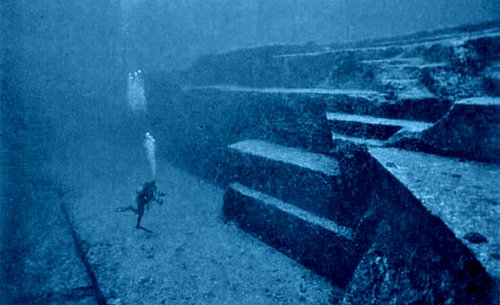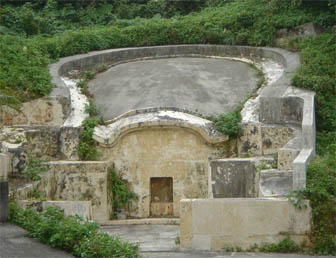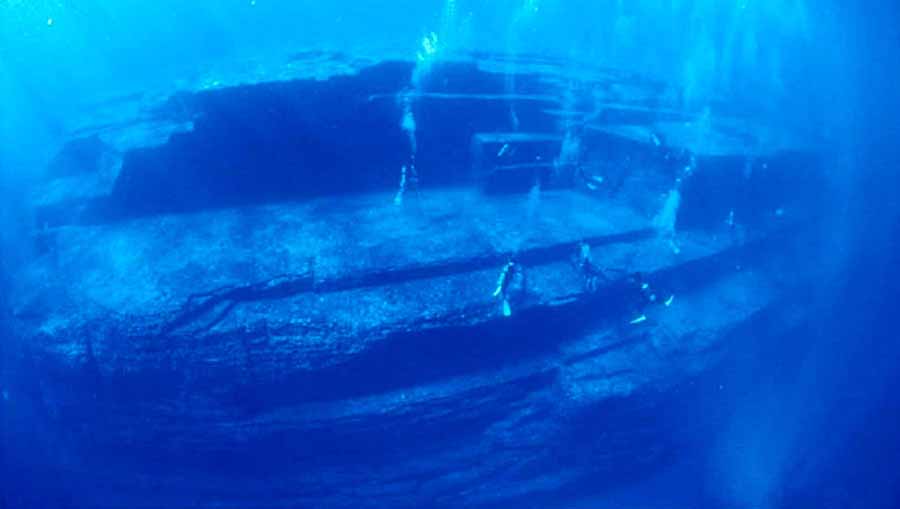Yonaguni Underwater Monument
Ruins of an Ancient Pyramid ?

In the oceanic abyss of the Japanese archipelago of Ryukyu lies a very ancient mystery. Off the small island of Yonaguni, during a scuba diving, the explorer Kikachiro Aratake made in 1985 a sensational discovery: a majestic rock formation, a sort of underwater pyramid, apparently shaped and sculpted by human hand. This exceptional discovery immediately raised questions about the dating of this unusual structure as well as the identity of the builders who erected this forgotten temple at the bottom of the ocean.
Yonaguni underwater pyramid

After years of research coordinated by Masaaki Kimura, professor of oceanography at the University of Ryukyu, datation of the underwater ruins seem to identify a single block of carved stone, 20 meters high, 200 meters long and 150 meters wide. The structure is pyramidal with vast terraces, stairs and authentic avenues inside. Some geologists claim that the Yonaguni monument can only be the work of nature: a combination of natural underwater events could have caused a spectacular and geometric erosion of the submerged pyramid. According to Professor Kimura, however, there are two possible scenarios that agree with two plausible dates. In the first scenario, the entire area would have been submerged during the melting of the glaciers of the last glaciation, with the consequence of rising sea levels 10,000 years ago. According to this hypothesis, a very ancient civilization would have been destroyed during the climatic upheaval. In the second scenario, on the other hand, the Yonaguni ruins could date back to more recent times: between 4000 and 400 BC. In this case, its fall to the bottom of the ocean would be the consequence of one of the devastating earthquakes and tidal waves that regularly affect this region.
The legend of Taro Urashima

The inhabitants of the island relate an ancient local legend recounting the exploits of Taro Urashima, the hero who had been carried under water on the back of a turtle to the “palace of the god of the sea”. It is precisely this animal which seems to have been carved inside the Yonaguni underwater ruins ; indeed, a section of the underwater pyramid is called the “Sacred Area” because of some strange discoveries that took place inside: a stone bird, a triangular basin and a rock carved in the shape of a turtle, very similar in kamekobaka, the tortoise shell tombs typical of the Okinawa tradition.
A very strange underwater monument

Bounded by a wall which only opens a vaulted door, a circular path 6 meters wide and 15 meters in short diameter around the central body of Yonaguni - a tiered structure. On the outside of this ring which defines the perimeter of the main underwater pyramid, rise five other smaller buildings. The facade of the building is oriented to the south and it is from there that the stairs lead to the “Sacred Area” (to the east) and to the “Terrace” (to the west), the latter being characterized by sections of rock perpendicular to each other and perfectly cut at right angles. At the highest level of the underwater ruins, there are three large cylindrical holes that can support large pillars, perhaps collapsed, and a hatch which gives access to a sort of burial chamber below. Another structure, called Goshintai, contains a fascinating stone which, according to some researchers, could have functioned as a very ancient sundial. Outside the main complex, all the other constructions are connected by paths, like the one leading, for example, to this impressive megalith which reminds one of the moai of Easter Island. It is 7 meters high, and on its upper part, incisions are made which seem to evoke the features of a face and two horizontal cracks called "Jacques' eyes" in honor of Jacques Mayol, the great French freediver who died and who was in love with the Yonaguni underwater pyramid.
A lost civilization?
Could the enigmatic Yonaguni underwater ruins be the work of nature ? Or should we rather think of a civilization which would have disappeared thousands of years ago, without leaving any other trace of it, apart from this underwater pyramid? Among the proponents of the human hypothesis, many invoke the legend of Mu, the hypothetical continent which would have existed in the distant and forgotten past, before disappearing in the Pacific - precisely between Japan and South America. The only thing we can be sure of is that on the dates provided by scientists as possible periods for the realization of Yonaguni underwater ruins, no advanced civilization was established on the Japanese island. It seems that the truth about the Yonaguni pyramid is well kept at the bottom of the ocean.









































































































































































































































































































































